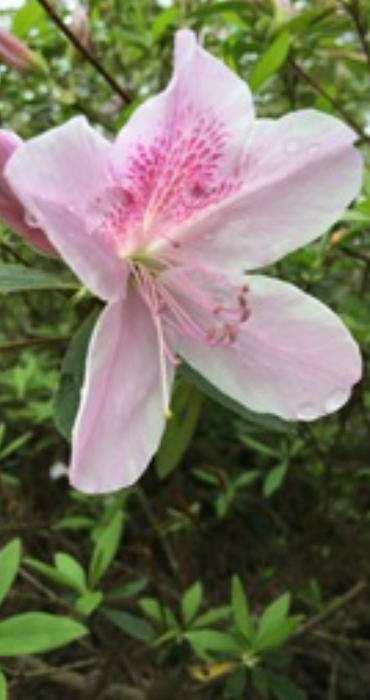Ask Master Gardener Volunteer JoAnn Green

One of the first ornamental shrubs to bloom in late winter or early spring in my shady landscape is the azalea. They bring a burst of color to an otherwise dull winter landscape in February and March. To me, azaleas, along with southern magnolia, are the plants that epitomize the South. It is no wonder, that these flowering shrubs appear on magazine covers, newspaper stories, and in gardening books. With a little planning and care, most homeowners in our area (zone 8b) can grow these delightful plants.
Planning for Azaleas
Azaleas do best in partial or dappled shade. I have seen shrubs planted in areas that receive direct sunlight for up to 6 hours of sun; but on further inspection, those plants that are doing well appear to have some shade protection from the hot, late-afternoon sun in the summer. If you plan to plant azaleas where they will receive 6 or more hours of direct sun, be prepared to irrigate these plants more frequently, especially during periods of little or no rain.

There is also some planning if you want to establish azaleas under existing trees or as a foundation plant along your house. When preparing beds and planting plants under trees, take care when working around the tree roots. Do not saw or cut large roots and do your best to minimize disruption of the finer roots. Go with smaller plants and dig smaller planting holes. It may take a few more years for these smaller plants to reach a desirable height, but you will save your trees. And if digging around your house foundation, be sure to call 811 to make sure you are not digging around wires or water lines. Around foundations, you will want to look for dwarf or medium size azaleas at maturity. Otherwise, large azaleas will grow up in front of windows and spread up against walls.
Azaleas do best in acid soils (pH of 4.5 to 6.0). A good step in the planning stage is to have your soil tested (see link at bottom of this article). Prior to planting azaleas in my landscape beds, I worked compost into my sandy soil. The organic material helps with water and nutrient retention and also helped to lower the soil pH.
Care and Maintenance
Mulch: I make sure to have a 3 to 4-inch layer of mulch around my azaleas. They have very fine and shallow roots, so the mulch helps to protect the roots and maintains moisture. Pine straw, pine bark, or oak leaves also help to acidify the soil on the top layer – an added benefit.
Fertilizer: In late winter (Jan/Feb) and again in mid-summer (June) I add sulfur around the base of the plants. The sulfur will temporarily lower the pH of the soil a bit, so the plants will be able to take up nutrients from azalea fertilizer. (See article about soil pH that gives a thorough explanation of lowering pH of alkaline soils.) I usually fertilize in late March or early April, when the plants are finished blooming. Look for fertilizer blends specific for azaleas.

Irrigation: Newly planted azaleas will need frequent watering until they are established. This is a good time of year to plant azaleas as the rains and cooler weather are conducive to root growth. The plants will also be in bloom so you can determine which colors you prefer. Once established, landscape azaleas will only need supplemental irrigation if they do not receive at least an inch of rain every 10 to 14 days.
Pruning: If you want to enjoy the spring flowers, do not prune azaleas until after they finish blooming. Light pruning up until July 4th can be done to encourage branching for a denser plant. After the first of July, do not prune azaleas as the flower buds begin developing for the next spring bloom.
I have enjoyed my beds of azaleas for over 20 years! They make a lovely evergreen screen throughout the year, and the flowers each spring are spectacular. So far, pests and disease have not been a major problem. I hope this luck continues.
Azaleas at a Glance: https://edis.ifas.ufl.edu/pdffiles/MG/MG01900.pdf
Soil pH and the Home Landscape: https://edis.ifas.ufl.edu/pdffiles/SS/SS48000.pdf
If you have any questions or suggestions for future articles please email to wakullamg@ifas.ufl.edu
| The Institute of Food and Agricultural Sciences (IFAS) is an Equal Opportunity Institution authorized to provide research, educational information, and other services only to individuals and institutions that function with non-discrimination with respect to race, creed, color, religion, age, disability, sex, sexual orientation, marital status, national origin, political opinions, or affiliations. U.S. Department of Agriculture, Cooperative Extension Service, University of Florida, IFAS, Florida A&M University Cooperative Extension Program, and Boards of County Commissioners Cooperating |
 0
0




